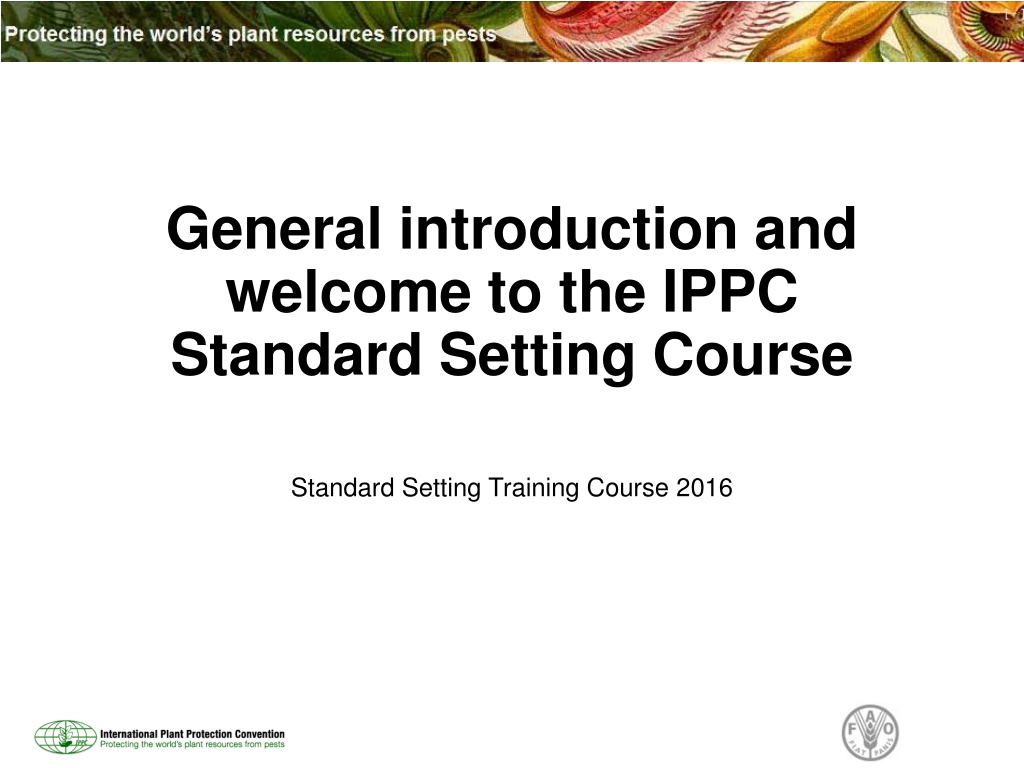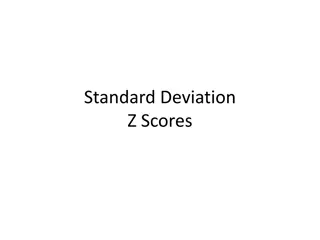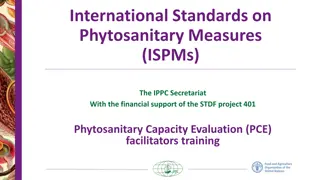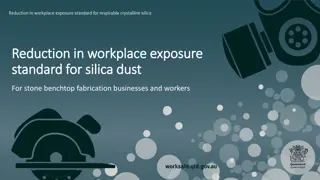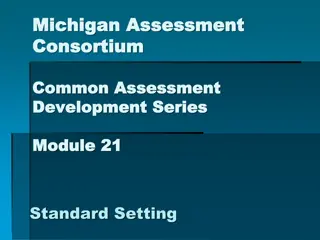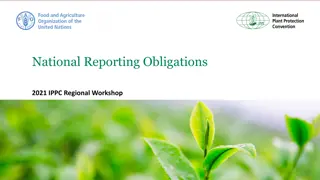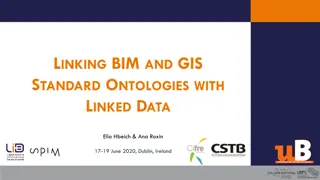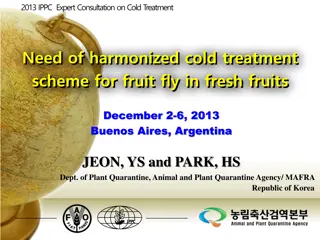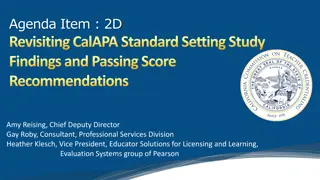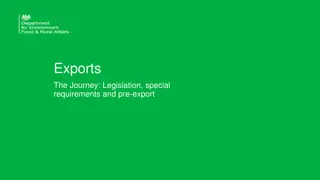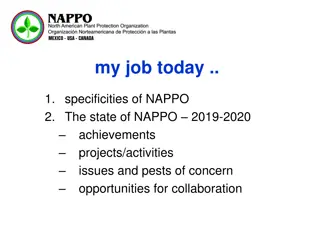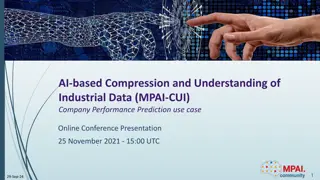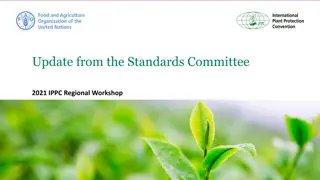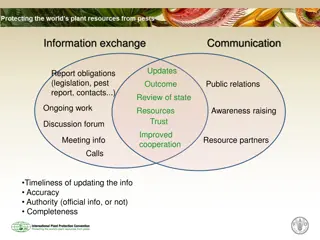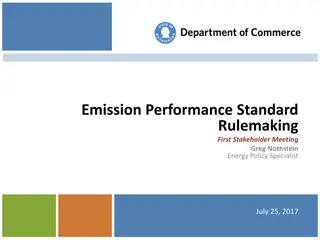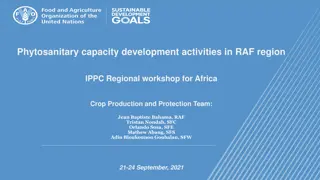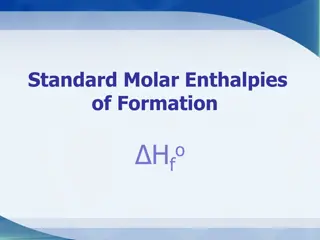Understanding the IPPC Standard Setting Process - A Comprehensive Overview
Explore the IPPC standard setting process through this course, covering the steps involved, bodies and roles, and ways NPPOs can contribute. Gain insights into the roles of various entities like the Standards Committee, Expert Working Groups, and more. Understand the significance of the IPPC Secretariat in coordinating the process and enhancing global phytosanitary standards.
- IPPC Standard Setting
- Phytosanitary Measures
- NPPO Involvement
- Standards Committee
- Global Coordination
Download Presentation

Please find below an Image/Link to download the presentation.
The content on the website is provided AS IS for your information and personal use only. It may not be sold, licensed, or shared on other websites without obtaining consent from the author. Download presentation by click this link. If you encounter any issues during the download, it is possible that the publisher has removed the file from their server.
E N D
Presentation Transcript
General introduction and welcome to the IPPC Standard Setting Course Standard Setting Training Course 2016
What well see over the next three days The steps of the standard setting process Bodies involved and their role(s) How can a NPPO be more involved? What are the benefits? And more 2
Before we start We d like to know more about you: Introduce yourself, your organization, your background What experience do you have with standard setting? What do you know about the process? What do you think about it? Any concern? What are your expectations of the course? Introduction 3
Your knowledge of the process One by one, use the flipchart to draw your interpretation of the IPPC standard setting process Identify, in color, the steps where you think NPPOs can contribute Introduction 4
Bodies and Roles involved in the IPPC Standard Setting Process Standard Setting Training Course 2016 Introduction 5
Overview Bodies Commission on Phytosanitary Measures (CPM) Standards Committee (SC) Expert working groups (EWG) Technical panels (TPs) Introduction 6
Overview (contd) Roles Contracting parties and NPPOs RPPOs Experts Stewards Chairperson Rapporteur FAO country representatives Introduction 7
IPPC Secretariat Coordinates the standard setting process: Standard setting Information exchange Technical assistance Main contact between all payers involved Introduction 8
Standards Committee (SC) Established during the first session of the Commission (CPM-1 (2006)) as the body in charge of standard setting 25 members from seven FAO regions One SC member/region selected for the SC Working Group (SC-7) Introduction 9
Standards Committee 25 members from 7 FAO regions Europe(4) North America (2) Near East (4) Asia (4) Africa (4) Latin America & Caribbean (4) Southwest Pacific (3) Introduction 10
Process to nominate SC members FAO Notification of vacancies IPPC Regional Chair* Secretariat Nominations from region *Selection process as decided by the region Nominations CPM Approves members CPM Report Introduction 11
SC member selection: what is needed? Secretariat sends a notification to Chairperson from each FAO Region Regional Chairperson collects nominations, including: Nominee s name and contact details Nominee s curriculum vitae (CV) Statement of commitment Nominations are presented to CPM CPM confirms nominations Introduction 12
Who to nominate as SC member? Senior officials of NPPOs with: Qualifications in a scientific biological discipline (or equivalent) and in plant protection Experience and skills in: Practical operation of a national or international phytosanitary system Administration of a national or international phytosanitary system Application of phytosanitary measures related to international trade Introduction 13
Who to nominate as SC member? (cont d) A nominee with adequate time and an immediate supervisor who understands the time commitment of being an SC member Introduction 14
SC replacement members FAO region nominates potential replacements (confirmed by CPM) A member is replaced if: He/she resigns He/she no longer meets the qualifications He/she fails to attend two consecutive meetings Contact point should notify Secretariat if SC member needs to be replaced Replacement will serve through the completion of the term, and may be nominated to serve additional terms Introduction 15
SC members (contd) Annual time commitment? 3-4 weeks for meetings (preparation and attendance) 2 weeks for revision of drafts 1 week for electronic decision making May be more if the SC member participates in a regional workshop or is a steward Communication at the regional level: SC members contribute to the communication of information related to draft ISPMs with the countries within their region Introduction 16
SC working group (SC-7) Scope Supports the work of the SC in the detailed consideration of documents Decision-making Consensus If no consensus, matter deferred to SC Introduction 17
Expert Working Group (EWG) 6-10 experts working together to develop a draft standard Once the SC has approved a specification, NPPOs and RPPOs can nominate experts to be members of the EWG SC reviews nominations and selects the members of the EWG Introduction 18
EWGs (contd) Represents a wide geographic area through its members (including proportional developing country participation) Includes a member from the SC, if possible (e.g. steward) Representatives of industry, stakeholders or others may be invited to provide expertise, but not to participate as members Introduction 19
What are the responsibilities of an EWG member? Prior to EWG meeting, members should: Prepare and read draft discussion papers Search for information Participate in e-mail or virtual discussions During EWG meeting, members develop a draft standard Draft standard is then approved for member consultation or returned to EWG by the SC Introduction 20
Stewards of EWGs Who can be a Steward ? Senior plant health officer or scientist familiar with the standard setting process Should be drawn from SC or TP, if possible Involvement At least 2-4 weeks per year, per draft ISPM Depends on the complexity of the draft ISPM, what stage the draft ISPM is at, etc. Introduction 21
Stewards of EWGs (contd) The steward is expected to: Be the main driver behind the drafting of the standard Have a good understanding of the specification Explain the requirements of the specification to the EWG Liaise with the Secretariat Assist with the running of the meeting Assist the Secretariat to finalize the draft standard Assist the Secretariat in the preparation of the meeting report Introduction 22
Roles of EWG members Experts should: Prepare discussion papers Actively prepare for, and participate in, the EWG meeting and in e-mail discussions prior to and after the meeting Assist stewards as needed, particularly when reviewing country comments Respond to comments provided on draft ISPMs Take responsibility for their travel and accommodation arrangements, and visa requirements Introduction 23
Technical panels (TPs) Develop select draft ISPMs TPs have specifications to determine their scope and functioning Each TP has a Steward and a Secretariat lead Introduction 24
TPs (contd) Five TPs: TP on pest free areas and systems approaches for fruit flies (TPFF) TP on Phytosanitary Treatments (TPPT) TP on Glossary (TPG) TP on Diagnostic Protocols (TPDP) TP on Forest Quarantine (TPFQ) Introduction 25
Nominating experts for Technical Panels (TPs) Standard Setting Training Course 2016 Introduction 26
Technical panels (TPs) - what are they? Main objective is to develop specific draft standards, annexes, supplements, amendments or additions to standards on topics in their subject areas Introduction 27
TPs work Work according to specifications developed for each of them and approved by SC Assist the work of the SC and provide advice in their specific subject area on: Draft technical standards Country comments Topics and priorities for technical standard development Each TP has a steward selected by the SC Introduction 28
TP on Diagnostic Protocols (TPDP) Develop diagnostic protocols (DPs) within the framework of ISPM 27:2006 Diagnostic protocols for regulated pests 8 members + 1 Steward Entomology, Invertebrates/entomology, mycology, virology, bacteriology, virology and backup for bacteriology, botany and nematology Introduction 29
TPDP Expertise Diagnostic expertise Between them, members should have practical expertise in: Diagnostic techniques Quality assurance Phytosanitary procedures Introduction 30
TPDP Tasks Identify the need for DPs and make proposals to SC on subjects for DPs in the List of topics for IPPC standards Identify experts for development or revision of a DP Supervise the development or revision of DPs Submit draft DPs to the SC Interact at later stages of development Introduction 31
TPDP Tasks (contd) Consider relevant aspects of quality assurance related to the development of DPs and their application Provide specific advice to SC and other TPs/EWGs on issues related to the correct nomenclature of pests Under the direction of the SC, consider other topics related to diagnosis of regulated pests Introduction 32
Development of a DP Lead author produces a first draft with assistance from editorial team Propose changes to the scope of the DP if needed Submits draft DP to the TPDP discipline lead A team provides input through the discipline lead at all stages of DP development Consultation of experts to improve quality of draft By trying to reach experts of the pest worldwide Especially those with a special expertise in relation to the pest but not part of the editorial team. Introduction 33
TP on the Glossary (TPG): A group with some history... Development of the Glossary (ISPM 5) started in 1986, with several groups involved over time: Consultations of RPPOs Glossary Working Group TPG 1986-1993 1994-2005 from 2006 onwards Some original developers still contribute to the work of the TPG - continuity is important Introduction 34
Also the Glossary itself has a history First version of the Glossary published in 1990 Now revised annually as ISPM 5 Contains 1 table of terms and definitions, 2 supplements and 1 appendix Published in all FAO languages Now also Online Glossary available from FAO Introduction 35
Considerations about terms Why define terms? To provide a reference and ensure a common understanding of phytosanitary terms in ISPMs and ultimately in real life ...across all FAO languages Why ensure consistency in the use of terms in ISPMs? Ensure ISPMs use the right terms as defined in ISPM 5 Ultimately to ensure a common understanding of ISPMs and phytosanitary regulations Introduction 36
So why a TPG? To provide the body able to review and update the Glossary of phytosanitary terms and deal with other matters related to the expression of technical issues in ISPMs in English, but also in all other FAO languages Introduction 37
Overview of the TPG Members: 1 Steward + 3 members for English + 1 member / FAO language Desired expertise: Strong language skills Solid understanding of phytosanitary systems and terms Active participation in the work of the panel Working knowledge of other FAO languages (bonus) Availability to volunteer for tasks on the work plan and interact with other members Introduction 38
TPG Tasks Reviews, revises and updates the Glossary Reviews draft ISPMs and makes recommendations related to: Terms and definitions in draft standards Member comments relating to terminology Consistency in the use of terms in standards Maintains the Annotated glossary Other tasks as determined by the SC and added to TPG work plan Introduction 39
TPG Other tasks - examples Reviews of adopted ISPMs for consistency Develops elements on the use of "should", "shall" and "must for the IPPC Style Guide Considers whether the duration of record keeping in ISPMs should be harmonized And as needed in the past or the future, acts as the EWG for some draft standards (e.g. supplements to the Glossary) Introduction 40
TP on Phytosanitary Treatments (TPPT) 9 members + 1 Steward Evaluates data submissions from NPPOs and RPPOs Reviews, revises and develops phytosanitary treatments Provides guidance to SC on phytosanitary treatment (PT) issues Introduction 41
Procedure for developing a PT Setting priorities for the TPPT work programme Call by the Secretariat for priority for PT TPPT reviews and recommends priority areas Call by the Secretariat for data for these treatments Evaluation of treatment submissions TPPT (or expert (s)) evaluates suitability as an international PT Acceptable PT will be forwarded to SC for consideration If more information is required or the PT is rejected, TPPT will contact the initiator Introduction 42
Data to submit for PT Efficacy data Experimental setting Operational conditions Information on a regulated commodity Feasibility and applicability Introduction 43
TP on Forestry Quarantine (TPFQ) 8 members + 1 steward Works closely with other TPs, especially TPPT when developing guidance related to treatments for forest commodities Introduction 44
TPFQ (contd) Deals with technical matters related to forest quarantine issues Primary function is to review technical and scientific information to provide guidance to the SC on the development, amendment and revision of ISPMs related to forest quarantine Introduction 45
TPFQ and IFQRG 1 member of the TPFQ is Chair of International Forest Quarantine Research Group (IFQRG) Provides a mechanism where critical forestry issues can be addressed through discussion and research Brings together scientists and phytosanitary officials Provides multi-disciplinary approaches to forest quarantine-related issues of global importance Introduction 46
TPFQ and IFQRG (contd) Advisory body to the TPFQ by providing scientific analysis and review of global issues Forum for the discussion and clarification of key issues related to phytosanitary implications of global trade Identify and undertake collaborative research aimed at high priority forestry quarantine issues Introduction 47
TPFQ procedures for reviewing treatments 1. Applicant identifies a treatment to include in an ISPM managed by TPFQ 2. Applicant forwards completed submission forms to the IPPC Secretariat, including supporting information as per TPPT requirements 3. Secretariat forward application to TPPT and TPFQ 4. TPPT and TPFQ consult with experts 5. TPPT recommends approval to TPFQ 6. TPFQ reviews against relevant ISPM 7. TPFQ recommends revision of the relevant ISPM to SC Introduction 48
TP on Fruit Flies (TPFF) Review of scientific data and draft ISPMs in support of international trade through the establishment of pest free areas and systems approaches for fruit flies Adopted standards: ISPM 26: Establishment of pest free areas for FF ISPM 30: Establishment of areas of low pest prevalence for FF Appendix 1 to ISPM 30: Fruit fly trapping ISPM 35: Systems approach for pest risk management of fruit flies ISPM 37: Determination of host status of fruit to fruit flies (Tephritidae) Introduction 49
Meeting Reports The EWG and TP produces a report of each meeting, noting major discussion points, contentious issues, and decisions The report is made available on the IPP Introduction 50
